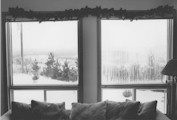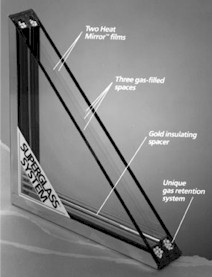Window window
Choosing a Well-Insulated Window

In addition to improving comfort, windows with high insulating values are less likely to have problems with condensation. Condensation occurs when warm, moist indoor air comes in contact with a cold surface, such as a poorly insulated window. Better insulating values are most valuable in cold climates. The bigger the difference in temperature between outside and inside, the faster heat will move through the window. You'll notice the difference if you replace an old window with a better-insulating one. For instance, when it is 0°F outside, the inside surface temperature of a double-pane glass window is about 44°F, but for a high-performance window it jumps to about 56°F. High-performance windows will help in the summer as well, particularly if you are trying to cool the house to 78°F as the outside temperature climbs toward 100°F.
You can tell how much heat a window allows through by its U-factor, which measures thermal conductivity. A lower U-factor means a better-insulating window. The more common term R-value refers to the resistance of the window to heat conduction, and it is the inverse of the U-factor (that is, R-value = 1/U-factor). Better windows have high R-values and low U-factors (see Table 1).
Since the different parts of a window all have different U-factors, you should look at the U-factor for the whole window. The frame and the edge of the glass usually have higher U-factors than the center of the glass. If they don't specify-and they often do not-manufacturers or dealers may refer to a window's center-of-glass U-factor, which is almost always lower than the U-factor for the window as a whole.
Fortunately, many new windows are labeled with an energy information sticker from the National Fenestration Rating Council (NFRC). The U-factor on the NFRC label always refers to the whole window. To make sure you are comparing apples to apples, ask for the NFRC ratings even when there is no label on the window (see "Window Ratings and Labels"). Also, be sure to use the same size windows for comparison, as the ratio of glass to framing affects the result.
Note: These are example of whole window U-factors of 3 ft x 5 ft windows. U-factors vary somewhat with window size. Ask the dealer for the specific values for the window you are looking at.
The first step to improving a window is usually to add a second pane of glass. This traps a layer of still air, a good insulator, between the panes. Double-pane windows insulate about twice as well as single-pane windows, so only half as much heat passes through the window.
The space between the two panes can also be filled with argon or, less often, krypton gas, which insulate better than air. Krypton is somewhat more effective in windows with less space between the panes (1/4 inch to 3/8 inch), so it is often used in windows with multiple air spaces (such as triple-pane windows) to keep the thickness down. Windows filled with air or argon work best when the space is about 1/2 inch. Windows with krypton are usually more expensive, both because krypton itself is expensive and because the designs tend to be upper scale. Argon is nearly as effective and does not add much to the cost of a double-pane window.

Energy-efficient features in this Superglass window include two low-e coatings, gas fills, and an insulating spacer.
Wouldn't it be nice in winter if you could let in heat from the sun, but keep the home's warmth inside? This is essentially what a low-emittance (low-e) coating does. A clear microscopic metal oxide layer installed on a surface of one of the panes of glass allows short-wavelength sunlight to pass through it, but reflects long-wavelength infrared radiation. The heat energy from the home (and people) that radiates toward windows is long-wavelength radiation, which is reflected back into the home.
Improved Frames and Spacers
Window frames are made from aluminum, wood, vinyl (polyvinyl chloride), or fiberglass. There are also composites of two materials (for instance, vinyl and wood) mixed together and formed or extruded like plastic. To achieve a certain look, manufacturers also offer vinyl or fiberglass frames with a thin veneer of wood on the inside (wood-clad vinyl). Others offer wood frames with a cladding of vinyl or aluminum on the outside for increased durability. The frame can account for about 15% of the energy loss through a window. Aluminum frames have high U-factors, unless they include a thermal break-a strip of urethane that interrupts the transfer of heat through the metal.
Wood, vinyl, and fiberglass are much better insulators than standard aluminum frames (without the thermal break). Of these, fiberglass performs slightly better than the rest and is also the most durable. You'll find that vinyl and wood frames generally have similar U-factors. Some very expensive vinyl frames are filled with urethane foam insulation.
In double- and triple-pane windows, the panes of glass are separated by spacers. The spacers are traditionally made of aluminum, even in wood, vinyl, or fiberglass frames, creating greater conductivity around the window edges. This makes the windows colder at the edges in winter, and water vapor may condense there as it hits the cold surface. New warm-edge spacers are made from better-insulating materials, and are recommended for cold climates. The biggest advantage to warm edge spacers is that they reduce condensation around the edge of the window.
Many people put up storm windows in the winter, and they do help. But storm windows are typically fairly leaky. If you are deciding whether to buy storm windows or replace your existing ones, you're probably better off putting your money into new double-pane windows.
Don't miss Part II: "Keeping Air Out, or In" of our weekly four part series on "Choosing a Window for all Seasons."
Комментариев нет:
Отправить комментарий